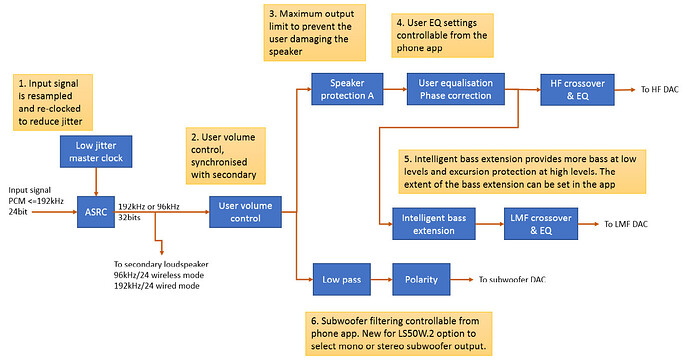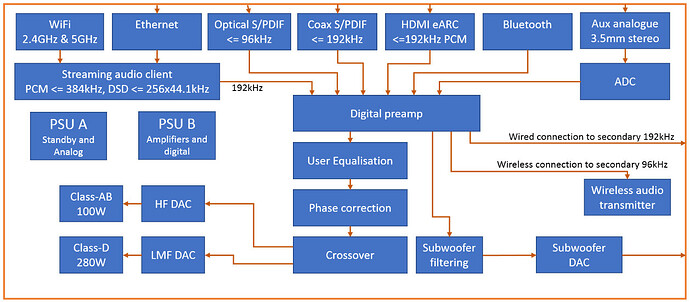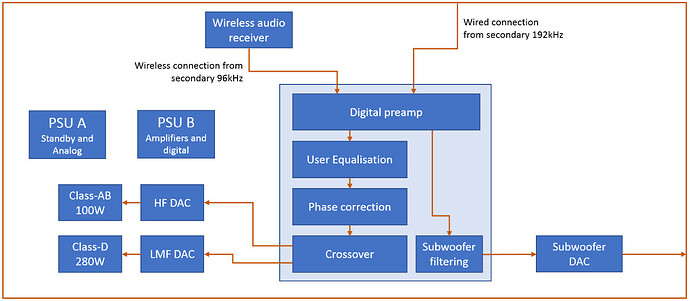If it’s different devices, it’s different clocking. As far as digital audio rendering is concerned, the only clock that matters is the DAC’s, so if another device is imposing its clock on the DAC, the latter has to go through hoops to stay in sync with it.
I see your point but I’d like to see a demonstration that accounts for a significant difference (and I mean an objective one).
Of course, I am speaking in the theoretical. It’s possible to demonstrate an objective difference by doing say a J-test. A good DAC and a decent S/PDIF source will most probably show little or no difference, and that difference will most probably be undistinguishable in a blind test. But we digress…
For quick and room measurement and eq you may want to look at housecurve, also discussed elsewhere in this forum. Any iPhone or iPad will do for starters. License is below ten USD/Euro, so you can just give it a try.
Thanks for the suggestion. Been in the headphone world so room measurement was not top of mind. I will look into it.
This will help fixing basic room modes and getting tonality right. I would suggest dialing KEF settings to neutral and do adjustments via roon using the measurements and roon peq settings, so there is one single place where you make changes to the system. Roons dsp is very sophisticated both quality wise and by offering all kinds of tools.
Me, too. Always. But the two paths are different. We don’t know exactly why the MU1 is in the chain producing S/PDIF; if it’s not changing the audio in some way, what’s the point? So perhaps it is. The KEF circuits interfacing with the S/PDIF inputs to the KEF are different from the KEF circuits interfacing with the Ethernet inputs, so there’s that, too. The packet formats are different, which shouldn’t matter. We don’t know about the KEF internals, so we can’t say whether it buffers and reclocks the S/PDIF signal in the same way it feeds the Ethernet packetized signal to the internal DAC; I’d expect that it does.
Too many unknowns.
Have you paired the LS60 with a subwoofer?
Personally, I found that in my large room, they really came to life when I connected a sub to them. Also, they sound best as the volume increases, say beyond ~45%, depending on the track and genre.
That’s why using an async interface like USB (or, in the case of KEF, Ethernet) is the best bet. The other inputs are useful only if using multiple sources.
The great thing about research driven companies like kef is that they publish in depth information on their products.
This Whitepaper on the LS60s little sister provides some clues on the signal flow.
The diagrams shown below are taken from this whitepaper. The illustrate the items discussed here in detail. It should be noted that ALL input signals are resampled and reclocked to reduce jitter.
DSP Details
Block diagram of Primary Electronics
Block diagram of Secondary Electronics
Signal flow in LS60 should be virtually the same.
Those diagrams are great, but don’t include enough detail to resolve what we were discussing. They point out that everything digital goes into the digital preamp, but not how conversions to the input format of the preamp are made. We do find out that everything is re-clocked, which is what I’d expect.
This info might save me some money! I wanted to try HQPlayer with the LS60’s but the only way to do it now is with a compatible streamer because the speakers dont support the NAA protocol. I hope they include this in a future firmware upgrade.
Anyway, the best sound I have been able to extract from them is using ROON convolution engine (HAF crosstalk filters) and DSD 256 upsampling. ROON server is in a MacMini M1 feeding the signal via optical ethernet and the end ethernet optical/analog converter is powered by an ifi X power supply.
I know that the LS60’s down sample the DSD256 signal, but the difference from feeding it a 24/192 signal is stark. The DSD signal sounds more organic and analogue like. This is why I started to think of integrating HQPlayer in the equation.
If you sit back and think about it for a second, the difference can’t possibly come from the fact that the signal went through a DSD format at some stage during playback. You start with a 24/192 signal and you end up with another 24/192 signal that is presented to the DAC. If there’s a difference between the two, in the absence of any other DSP (like the crosstalk fiters you mention), it can only consist of rounding errors, aliasing, random dither and maybe other undesirable artifacts. Now there’s a chance you like those artifacts, but if the DSP is done right, they should be well below audibility, so I think that’s a really slim chance.
Ok, but I dont think you understand what upsampling does in a 64 bit space. This has been discussed and debated ad nauseam. No need to do that in this thread again.
I do understand what up-sampling does, not sure what makes you think I don’t. I’m not sure what you mean by “64 bit space” though. And even after being discussed ad nauseam, some people still think there’s something misterios going on that explains what they think they hear.
I have fed my LS50WII just about every signal I could think of over the last few years: RoonReady plain, upsampled, HQPlayer upsampled DSD256 via analog, Apple Music via coax/optical/HDMI, Tidal Connect, Qobuz via Chromecast, Audirvana over UPNP, Plexamp – you name it, I sent it.
Conclusion after all of this: Spotify Connect is just fine.
Did you ever get to the bottom of why the Ethernet input sounds better than coax? I was disappointed to read this because I was also planning to use the coax input.
By any chance have you also tried the Wi-Fi input to see how it compares to Ethernet? I would be curious if it’s possible to improve upon the internal streamer with a dedicated streamer providing input to the LS60s or if the internal streamer is already as good as it gets.
I have come to accept that the LS60 is designed with wifi/ethernet streaming in mind. I have sent audio from an external DDC upsampler (Grimm MU1) into the coax/spdif input and external DAC audio into the analog inputs. To my ear, the ethernet/Roon input sounds the best. Now, I am not a good test case as I can’t listen to the LS60s at high volumes. When I have briefly done high volume listening the speakers come alive and much more detail can be heard. It’s entirely possible that in a larger room, at higher volumes, the differences between the inputs change. But, for now, in my situation, the ethernet/Roon input is fine. I use the LS60s now for more background listening and TV. When seriously listening to classical I go back to my headphones where it is easier to hear subtlety and detail in the early music and string ensemble music that I love. The LS60s have a lot of technology built into them. They probably aren’t made for the audiophile type tweaking such as external DACs, DDC upsampling, etc, that I am used to with my headphone rig. So, in answer to your question, I will say that I don’t really know if it is possible to improve on streaming to the ethernet/Roon or WIFI inputs. Others may have a more informed view.
My reading of the LS60 is close to plug n play, Ethernet in, Ethernet link maybe a bit of EQ in the Kef App
Done, sit back and listen
Why make things more complicated, let the designers fret ![]()


